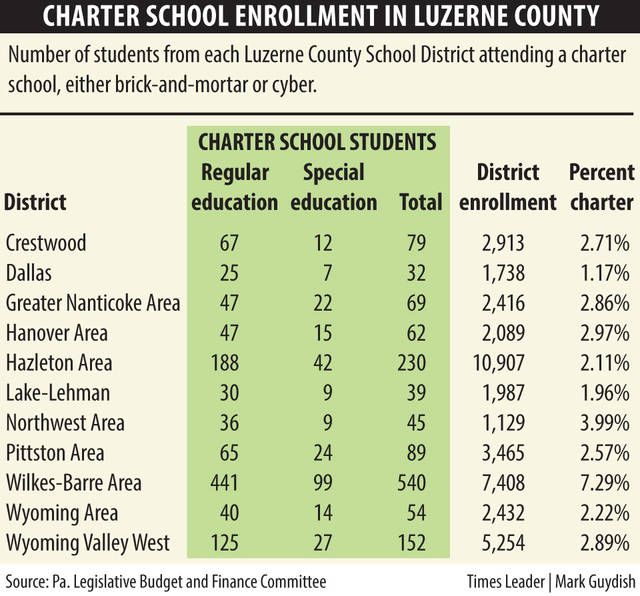Click here to subscribe today or Login.
Wilkes-Barre Area has by far the highest percentage of students enrolled in charter schools among Luzerne County’s 11 school districts, and pays the most per student for those charter school students, according to a new state report.
The Pennsylvania Legislative Budget and Finance Committee released “Public Charter School Fiscal Impact on School Districts” on Wednesday with a wide range of findings and recommended changes in the state charter school system, including revamping how charter schools are paid, and how much they get.
The report included data on how many students in each of the state’s 500 school districts attend charter schools, comparing that number to the district’s “Average Daily Membership” — the state measure of enrollment.
In Wilkes-Barre Area, the data showed 540 district students attended charter schools as of Oct. 1, 2015, while the district had a 2014-15 ADM of 7,408. That means the charter school enrollment was almost 7.3 percent of district enrollment.
By comparison, the next highest rate was 3.9 percent at Northwest Area, where 45 students were in charter schools and district ADM was 1,129.
The lowest rate in Luzerne County was a bit under 1.2 percent at Dallas, with 32 charter school students against a district ADM of 1,738.
The report also gave the per-pupil tuition rate paid by each district to charter schools for both regular and special education students, showing a wide range. In Luzerne County, Wilkes-Barre Area paid $11,165 for a non-special education student, the highest in the county, and $23,753 for special education, the second highest.
Greater Nanticoke Area paid the lowest for both: $7,534 and $15,595 respectively.
Some of the recommendations, and reasons for them:
• Change the charter funding mechanism so the state pays a larger share. In Pennsylvania, charter school funding depends heavily on local taxes, even for cyber charters which are authorized by the state (brick-and-mortar charters are authorized by the district where they are built). State-wide, 84 percent of charter funding came from local taxes, compared to 23 percent in New Jersey.
• Change the tuition payment formula for special education services. Statewide, in 2014-15 school districts paid $294.8 million to charter schools as special education tuition supplements, yet the charters reported spending $193.1 million on those services.
• Change the state mandates for transportation to charter schools. Pennsylvania is “unique” among states in requiring districts to provide transportation services for charter school students that the districts are not required to provide for their own students.
• Require multi-district charter schools to seek authorization as “regional charters” as provided by the state charter law. As a result of a court ruling, a school district that had nothing to do with the authorization of a charter school can end up paying tuition for students attending that school even if it is not in that district.
• Require parents to register their children in their home school district before enrolling in a charter school. Billing issues between charter schools and the school district paying them have developed when charter school students never attended a school in that district.
• Create clear conflict of interest policies, audit funds received by a charter school but transferred to associated entities, and close loopholes that have allowed what the report called “widely reported cases of fraud and abuse involving several Pennsylvania charter schools.”





